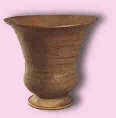| Art Q&A > Crafts |
|
|
Origin of Chinese Porcelain China is the hometown of porcelain and the invention of porcelain was China's great contribution to the world civilization. The word china when capitalized is recognized as the name of the country. Around 16th century BC in the middle of the Shang Dynasty (17th - 11th century BC), the early-stage porcelain appeared in China. The firing techniques were rough in both the bodies and the glazes and the firing temperature was comparatively low, so porcelain of that time is called primitive porcelain for its primitive and transitional nature.
Porcelain derived from pottery. The ancient Chinese ancestors invented porcelain, drawing on the experience of firing the white pottery and the hard stamped pottery. Firing porcelain requires the following three conditions: first, porcelain materials must be porcelain stone, porcelain clay or kaolin, containing rich sericite elements; second, the temperature of kiln stove must be up to 1200¡æ; third, surface of the vessels must be coated with glaze fired in high temperature.
Compared with other pottery, the primitive porcelain, with its transitional nature, is durable, easy to rinse, delicately decorated with fine roughcast, thus it has a good prospect of development. The improvement of the firing techniques and the increase of production promoted the development of porcelain. Porcelain finally replaced pottery and became major vessels for people's daily use. |
||
All rights reserved. Reproduction of text for non-commercial purposes is permitted provided that both the source and author are acknowledged and a notifying email is sent to us. |
||
 |
